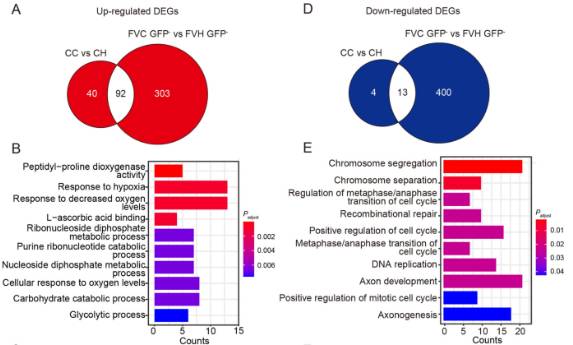
上海科技大学罗振革研究组在研究中取得进展。他报道了血管化脑类器官模型对缺氧损伤的神经反应。相关论文于2025年4月22日发表在《神经科学通报》杂志上。
本研究以血管化的脑类器官为研究对象,探讨缺氧条件下血管和神经组织之间的细胞间相互作用。他们的研究结果表明,与单一脑类器官相比,当暴露于低氧水平时,主题血管化脑类器官表现出更广泛的缺氧反应和更大的神经发育相关基因组的减少。有趣的是,血管也表现出对T-box脑蛋白2+中间祖细胞(IPs)的神经保护作用,这在HI脑类器官中明显缺失。
此外,该课题组人员确定了骨形态发生蛋白信号在保护IPs中的作用。因此,本研究建立了一个体外类器官系统,可以研究血管对缺氧条件下脑损伤的贡献,并为确定干预靶点提供策略。
据了解,产前缺氧损伤常引起新生儿神经功能障碍。由于难以获得临床样本,其分子和细胞机制尚不清楚。
附:英文原文
Title: Neural Responses to Hypoxic Injury in a Vascularized Cerebral Organoid Model
Author: Li, Yang, Sun, Xin-Yao, Zeng, Peng-Ming, Luo, Zhen-Ge
Issue&Volume: 2025-04-22
Abstract: Hypoxic injury (HI) in the prenatal period often causes neonatal neurological disabilities. Due to the difficulty in obtaining clinical samples, the molecular and cellular mechanisms remain unclear. Here we use vascularized cerebral organoids to investigate the hypoxic injury phenotype and explore the intercellular interactions between vascular and neural tissues under hypoxic conditions. Our results indicate that fused vascularized cerebral organoids exhibit broader hypoxic responses and larger decreases in panels of neural development-related genes when exposed to low oxygen levels compared to single cerebral organoids. Interestingly, vessels also exhibit neural protective effects on T-box brain protein 2+ intermediate progenitors (IPs), which are markedly lost in HI cerebral organoids. Furthermore, we identify the role of bone morphogenic protein signaling in protecting IPs. Thus, this study has established an in vitro organoid system that can be used to study the contribution of vessels to brain injury under hypoxic conditions and provides a strategy for the identification of intervention targets.
DOI: 10.1007/s12264-025-01396-2
Source: https://link.springer.com/article/10.1007/s12264-025-01396-2
Neuroscience Bulletin:《神经科学通报》,创刊于2006年。隶属于施普林格·自然出版集团,最新IF:5.6
官方网址:https://link.springer.com/journal/12264
投稿链接:https://mc03.manuscriptcentral.com/nsb
